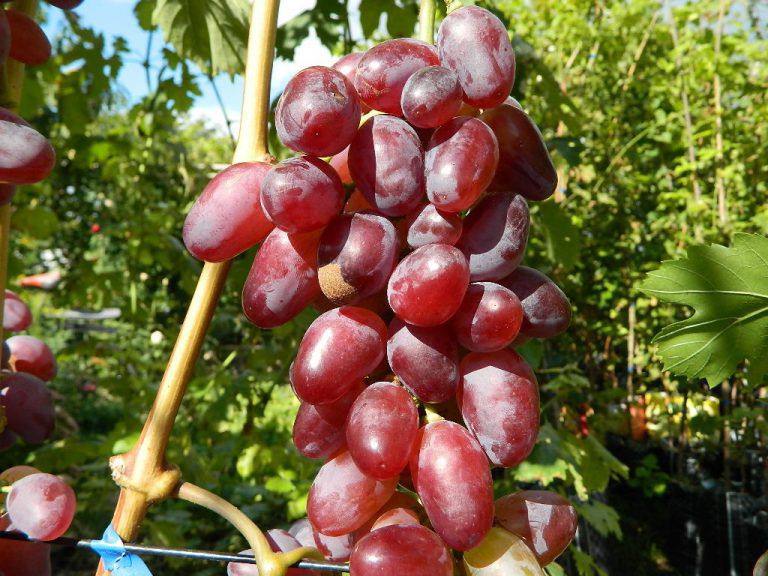
The prevailing requirements for grape crops are excellent fruiting, large fruiting and unpretentiousness to growing conditions. The new Baikonur variety has all these qualities. A large-fruited hybrid was first grown in the Pavlovsky nursery when crossing the popular varieties Beauty and Talisman. Grapes inherited all the best qualities from their parents.
Content
Grade Features
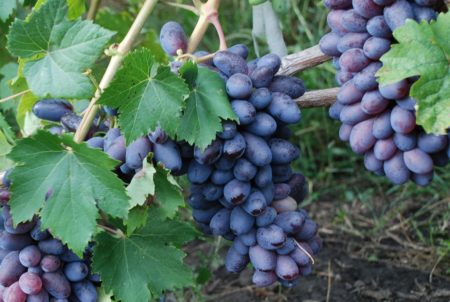
Baikonur has good survival. Grown in many regions of our country. Bushes withstand severe frosts. They can breed even in the suburbs. Here grapes are an overlying crop - for wintering it must be packed in boxes.
From the "Talisman" variety inherited great vitality. Culture is unpretentious in leaving. Even novice growers can grow it. Shoots grow gigantic, can reach four meters in length.
From "Beauty" grapes inherited the excellent fruiting and quality of berries. Fruits grow large. They have a special flavor that is difficult to compare with any other variety. The collected clusters for a long time retain an attractive presentation. They can transport over long distances.
Baikonur is a universal grape. Its fruits are suitable for fresh consumption. They also make jam, compotes, and prepare meat dishes. The variety is also interesting for winemakers. From the berries get excellent homemade cordial, wine, cognac.
Since culture has only been bred, its features have not yet been fully disclosed. To judge the resistance of the vine to weather conditions, to pests and diseases, it is necessary to observe the plant for at least ten years. Grapes are too “young” and do not yet have these statistics.
Culture Description
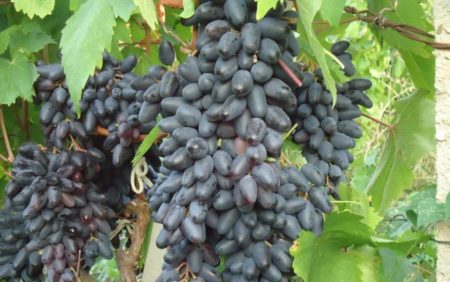
Grapes are growing rapidly. In the third year of development, it has a developed structure. Reaches four meter height. The bark of the trunks is light brown, strong. Propagate the culture by seedlings and with vaccinations.
It is rapidly gaining leafy mass. There are so many leaves that when growing you have to pinch them repeatedly. Sheets have a classic carved shape, dark green. They have pronounced veins.
Bisexual flowers that do not require additional pollination. The crop can be planted separately from other varieties. The first fruits ripen 3.5 months after spring vegetation. Harvest can be harvested in the last decade of July - in the early days of August.
Berries have an elongated oval shape. They can reach a length of 4 cm. When ripe, they weigh 14 - 16 g. They have a different color: from blue-black to reddish-lilac. Top covered with dense skin, which does not burst in wet weather. The fruits have a light waxy coating of black shade.

The taste of fruits is delicate, with a fruity hue. The same aroma. The pulp is dense, crispy. The berries contain enough sucrose (up to 20%), which is combined with a slight acidity. The skin is edible, quite soft.
The clusters are conical, of medium friability. They have branched brushes. In the first crop they ripen, reaching a weight of 700 g. Later at good care can weigh about a kilogram.
Sometimes so many clusters grow on a growing plant that there is a need for their artificial removal. Otherwise, the plant simply could not cope with the abundance of berries, would not have time to prepare for wintering. In some cases, the vine breaks due to the exorbitant weight of the berries. There is evidence that with abundant fruiting, grapes are prone to irrigation.
The culture has sufficient resistance to weather conditions. When the cluster ripens, it is not necessary to immediately remove it from the bush. They retain their presentation and taste throughout the entire time of hanging on the bushes.
Advantages and disadvantages of the variety
Despite the "young" age of culture, "Baikonur" has established itself as an excellent variety with a number of advantages. It is interesting for commercial cultivation, as well as for winemaking. Lovers-growers note the following advantages of the plant:
- powerful bush structure;
- rapid vine growth;
- resistance to frost;
- the presence of male and female flowers on one bush;
- large-fruited;
- excellent taste of berries;
- fruiting duration;
- the ability to withstand berries on the bush for a long time without losing their properties;
- good adaptability to various environmental conditions;
- resistance to fungal diseases.
The lack of variety is recognized as insufficient knowledge. Information about how hardy the culture is, so far, is insufficient. Some winegrowers complain about the seeds. They are often poorly separated from the pulp.
Disease and pest resistance
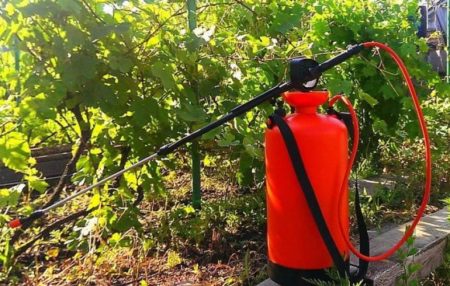
In most regions grapes are grown in a non-covering manner. The culture withstands frosts to minus 23 degrees.
As far as the variety is resistant to pests and fungal diseases, winegrowers are only studying. According to reports, his immunity to mildew, gray rot, oidium is estimated at 3 points. Sufficient attention should be paid to disease prevention.
To do this, take the following measures:
- in autumn, cut bushes and eliminate fallen leaves;
- dig the ground at the roots and carefully mulch. For mulch, dried moss, straw, dry sawdust are suitable;
- constantly tie the growing vine;
- during fruit setting, the plant is treated with special substances.
Some amateur winegrowers prefer the fungicide Carbio Topu. This drug is suitable not only for prevention, but also for damage to the plant with fungal diseases. It is rapidly absorbed and not washed off by seasonal rains. It is not harmful to beneficial insects.
Processing bushes during fruit ripening is necessary. Do not be afraid that it will affect the yield or quality of the berries. "Baikonur" - a universal culture, gives abundant harvests. The fruits are of good quality and great lightness. With good proper care, it is possible to achieve large yields.
Features of agricultural technology. Breeding methods
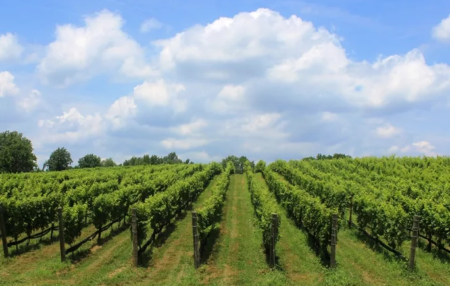
Grapes propagated by seedlings, vaccinations and layering. If Baikonur was not previously grown on the site, it is recommended to plant it with seedlings. Then you get a beautiful landscaping of the site and a plentiful harvest of large and tasty berries.
Vaccinations can be done to the old variety. The advantage of this method of reproduction is the presence of a developed root system and an adult trunk of the old culture. A new shoot is developing fast enough. The disadvantage of this method is that a new culture can adopt features of a strictly bush.
For propagation by layering, you must already have an adult parental bush. Sprout grapes sprinkled with earth and wait for the development of the root system. Further, the layering is dug out and transplanted to another convenient place. The advantage of the method is the cultivation of layering can be done throughout the year.
Grape planting
Baikonur, like everyone grape varietiesheat-loving. Therefore, the landing site must be allotted on the south or southwest side of the site. To avoid winds, it is necessary to plant it on the leeward side not far from the fence, the wall of the house or the barn.
Landing should be done on the hillocks. The lowlands are not suitable, since water will stagnate in them during irrigation. From severe waterlogging, the plant will hurt, and be affected by fungal diseases.
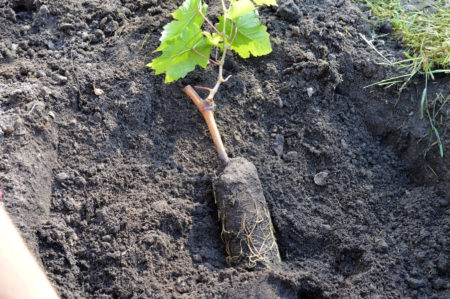
Bushes are unpretentious to soils. When planting, only one condition must be observed - the occurrence of groundwater must be at least 2 m above the surface. On alumina and clay soils it grows well, provided the land is ennobled. Sand and fertilizer must be applied to such soils.
At planting grapes should consider the distance between the bushes. It should be at least 3 m, and in the row-spacing - 4 m. Prepare for landing in advance, preparing the pits. In the southern regions, their depth is 60 cm, in the north - at least 80 cm. In arid regions, their depth is more than 80 cm.
To equip the pit, preliminary drainage is required. To do this, beaten brick or crushed stone is poured onto the bottom by 20 cm. Well tamped. Next, a layer of fertile soil is poured with the addition of decayed manure.
The peculiarity of the variety is that its roots should not touch the soil with fertilizers. Therefore, ordinary chernozem is poured over fertilized soil. Prepared pits should stand for 14 days.
Grapes in prepared pits can be planted from spring to mid-summer. Initially, seedlings are used as planting material. Closer to summer, more tall and developed plants are planted.
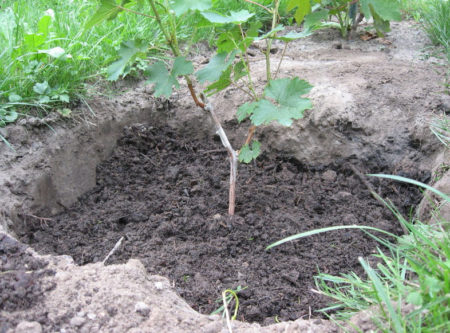
Landing can be done in the fall. Most suitable mid-autumn. In early autumn, planting a variety is undesirable. It is not only well rooted. Shoots can grow, and the plant does not have time to prepare for wintering. The bush will simply freeze.
When planting seedlings, they are installed in the center of the pits and covered with loose soil. The soil is thoroughly mulched from above. Mulch protects the plant not only from pests and fungal diseases. It does not allow the earth to dry out yet; it helps to maintain relative humidity in the root system of the bushes.
Cuttings are transplanted in the spring, early March. Although some growers believe that it can also be produced in mid-autumn. Only in this case, the plant requires warming for the winter. Before wintering, layering is sprinkled with earth and plastic buckets are installed on top.
To implement the vaccine, the stalk is prepared in advance. It is cut from two sides, and for some time placed in water. Top can be treated with paraffin, so as not to rot. The stock is also prepared in advance.
Pre-cut the stems of an old grape bush. Only a stump with even cut edges should remain. Then a slot is cut through it and the prepared cuttings are inserted there. The stock and the lower part of the handle should fit snugly against each other.
The finished vaccine is wrapped tightly with dressing. Then coated with clay. The stem is watered and mulched with straw.
Landing care
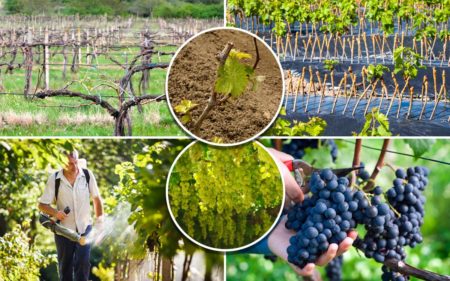
Developed grape bush requires double watering. The soil must be moistened constantly until the formation of the ovary. During this period, watering is usually stopped. However, in a particularly arid summer, watering can continue until the berries ripen.Grapes have a strong skin, do not crack when exposed to moisture.
Despite the unpretentiousness in care, the variety loves top dressing. In the spring, you need to dig humus and superphosphate fertilizers into the soil around the root system of planting. In the summer, before and after flowering, ash is introduced into the soil and foliar fertilizing with complex fertilizers is done.
"Baikonur" refers to high-yielding varieties. Sometimes so many berries are formed on one vine that normalization is required. It is recommended to leave no more than one or two clusters on one shoot. Moreover, the ripening of the fruit slows down if two clusters are left.
In the spring and autumn periods required pruning bushesforming a crown. During the formation of the ovaries, stepsoning and thinning of the leaves are carried out. The deciduous mass is plucked so that 14-15 leaves are left over the bunches. If this is not done, the greens will clog the berries and irrigation will begin.
Autumn pruning is carried out in order to form a crown. Apply short, medium and long trim. With a short leave three buds on one vine, with an average - eight, and with a long - up to 14 pieces. Spring pruning is carried out to remove frozen shoots.
Since Baikonur is a frost-resistant variety, covering it in the southern regions is not required. Only in the northern regions (for example, in the Leningrad region, in the Moscow region) the vine is bent and dug up.
Storage Features
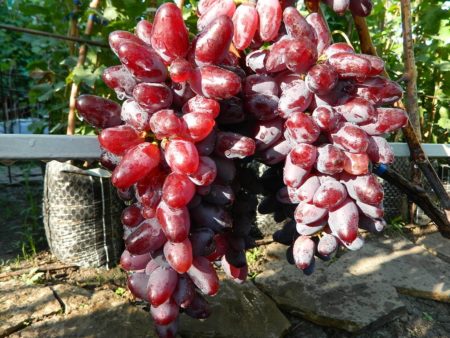
Harvesting dates for the variety are not provided. Matured, it can hang on the vines until late autumn. Moreover, the fruits do not rot, regardless of the amount of rainfall. Keep their fresh and attractive appearance for a long time.
Cut clusters can be kept fresh for a month. They are not stacked very tightly one on top of another in a cool cellar or refrigerator. Grapes tolerate lengthy transport. Under all conditions, retains an attractive appearance.
Reviews of amateur winegrowers
Lyudmila, 46 years old
For four years now I have been growing Baikonur. Very beautiful grapes. The clusters are conical, the berries are elongated. They have a pleasant delicate fruity aroma. Grow up to 4 centimeters in length. The pulp is dense, crunches. The taste of berries is very delicate, fruity. We eat fresh. Another husband is preparing wine.
Andrey, 57 years old
I have been growing Baikonur for the second year now. There are planting seedlings and vaccinations. Recently compared bushes. On a grafted plant, the fruits are larger. Ripened by the end of July. And he was harvesting on August 16th. And the night before, heavy rain fell. Not a single bunch was hurt. The berries of the grapes are very large, dark lilac with a blue coating. Very good grade. I have not seen the best for many years.
Maxim 32 years
Baikonur is a very worthy variety. Unfortunately, the vaccinations of this variety that I did last year did not take root. But this season I will try to vaccinate again. Already prepared cuttings. I really want to grow this variety on my site.
Although grapes appeared relatively recently, it gained a good reputation among amateur growers. Great interest in Baikonur is manifested not only due to the fact that he is unpretentious in growing. Its fruits have a universal purpose. Well stored and suitable for long transportation.




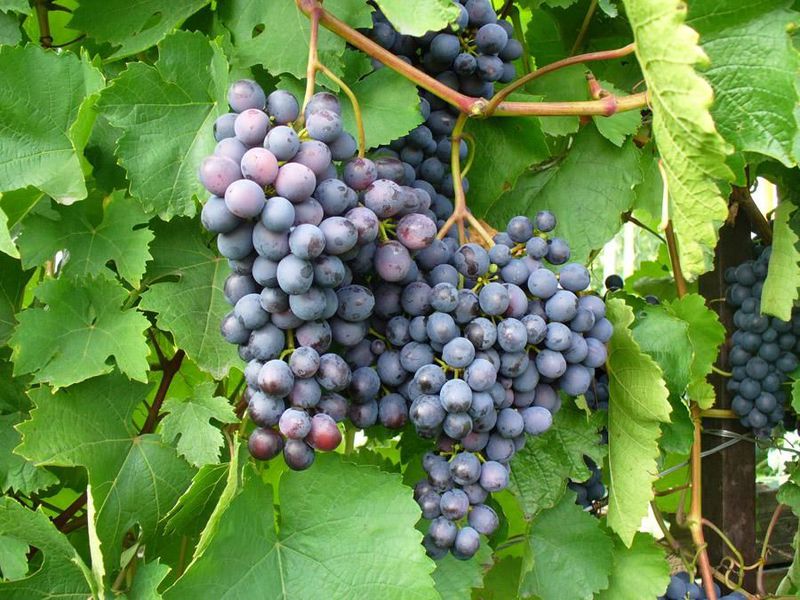
 Non-covering winter-hardy grape varieties for Moscow region
Non-covering winter-hardy grape varieties for Moscow region How to keep the vine in winter
How to keep the vine in winter When can I transfer grapes to another place in the fall
When can I transfer grapes to another place in the fall How to cover and prepare grapes for the winter in the suburbs
How to cover and prepare grapes for the winter in the suburbs